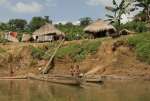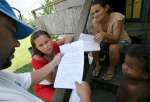An innovative project helps 26,000 refugees in northern Ecuador
Briefing Notes, 6 April 2010
This is a summary of what was said by UNHCR spokesperson Andrej Mahecic – to whom quoted text may be attributed – at the press briefing, on 6 April 2010, at the Palais des Nations in Geneva.
An innovative registration initiative has resulted in 26,000 Colombian refugees receiving identity documents in an isolated region of northern Ecuador. For 12 months mobile teams comprising officials from the Ecuadorian Ministry of Foreign Affairs and UNHCR staff traversed difficult terrain in northern Ecuador to reach the refugees. Registration is a vital step in the process towards being formally recognized as a refugee. The project is considered a model for Latin America, where the majority of refugees often have to go to towns and cities to be registered.
Known as the Enhanced Registration Project, this joint initiative with the Ecuadorian government was established in an attempt to reach Colombian refugees who fled to northern Ecuador. By using mobile registration teams, the waiting period for a government decision on asylum claims was reduced from several months to just one day. Recognized refugees received an official government document certifying their status as refugees. The cases requiring further analysis received a provisional document confirming their status as an asylum seeker. Without such documentation refugees and asylum seekers lack essential legal protection and access to assistance.
Many refugees have been living in this remote border location for years and were unable to access asylum procedures in urban areas either because of lack of resources and information or because of fear. Without legal status a majority of these refugees became vulnerable and marginalized. Documentation makes a real difference in the lives of these refugees who are now able to move freely in Ecuador and can access health centres, schools and other services. But, this is just a first step and additional efforts are needed to help these refugees to integrate into isolated host communities. The project aimed to reach the most vulnerable, including children, women and elderly.
UNHCR supported the Ecuadorian government in this complex protection and logistical effort that cost over $2 million. As a result of this initiative, the Ecuadorian government and UNHCR have a more accurate picture of the number of Colombian refugees living in northern Ecuador and the needs. This project doubled the number of registered refugees in Ecuador now totaling more than 45,000, 98 percent of them are Colombian. However, UNHCR estimates there could be another 100,000 people in Ecuador who may be in need of international protection.
The recording, verifying, and updating of information on people of concern to UNHCR so they can be protected and UNHCR can ultimately find durable solutions.
Panama's Hidden Refugees
Colombia's armed conflict has forced millions of people to flee their homes, including hundreds of thousands who have sought refuge in other countries in the region.
Along the border with Colombia, Panama's Darien region is a thick and inhospitable jungle accessible only by boat. Yet many Colombians have taken refuge here after fleeing the irregular armed groups who control large parts of jungle territory on the other side of the border.
Many of the families sheltering in the Darien are from Colombia's ethnic minorities – indigenous or Afro-Colombians – who have been particularly badly hit by the conflict and forcibly displaced in large numbers. In recent years, there has also been an increase in the numbers of Colombians arriving in the capital, Panama City.
There are an estimated 12,500 Colombians of concern to UNHCR in Panama, but many prefer not to make themselves known to authorities and remain in hiding. This "hidden population" is one of the biggest challenges facing UNHCR not only in Panama but also in Ecuador and Venezuela.
Panama's Hidden Refugees
Colombia: Assisting the Internally Displaced
Colombia is the worst humanitarian crisis in the western hemisphere. More than two million people have been internally displaced during the conflict, including 200,000 persons in 2002 alone. Tens of thousands of other Colombians have sought refuge abroad.
UNHCR provides legal assistance to these internally displaced persons (IDPs), supports their associations and on the national level has helped to strengthen government programmes and relevant legislation. Specialised agency programmes include education, psychological and social rehabilitation projects for children and their families and assistance to women who head households.
Colombia: Assisting the Internally Displaced
Panama's Hidden Refugees
Colombia's armed conflict has forced millions of people to flee their homes, including hundreds of thousands who have sought refuge in other countries in the region.
Along the border with Colombia, Panama's Darien region is a thick and inhospitable jungle accessible only by boat. Yet many Colombians have taken refuge here after fleeing the irregular armed groups who control large parts of jungle territory on the other side of the border.
Many of the families sheltering in the Darien are from Colombia's ethnic minorities – indigenous or Afro-Colombians – who have been particularly badly hit by the conflict and forcibly displaced in large numbers. In recent years, there has also been an increase in the numbers of Colombians arriving in the capital, Panama City.
There are an estimated 12,500 Colombians of concern to UNHCR in Panama, but many prefer not to make themselves known to authorities and remain in hiding. This "hidden population" is one of the biggest challenges facing UNHCR not only in Panama but also in Ecuador and Venezuela.
Panama's Hidden Refugees


Serbia: Presevo Crossing from FYR Macedonia
On October 20, the number of refugees and migrants arriving in Greece passed the half million mark. Their ultimate destination is northern Europe. The majority will take a route that goes from Greece, to FYR Macedonia and then onward through Serbia. At the border point of Presevo, Serbia they must go through a registration process before being allowed to continue their onward journey.


Greece: Registration Urgency
The Greek Island of Lesbos receives thousands of refugees and migrants every day.
A registration centre at Moria – the only hotspot on Lesbos – is working hard to process these new arrivals. But facilities are stretched. Most new arrivals are from Syria, Iraq and Afghanistan, but there are up to 20 other nationalities.


Croatia: A New Start
Croatia's new transit centre for refugees and migrants opened on Monday as thousands of Syrians, Afghans and Iraqis were bussed in from the Serbian border for registration, food and medical support, before continuing their journey onward to Hungary.
 |
|  |
|  |
| 







































